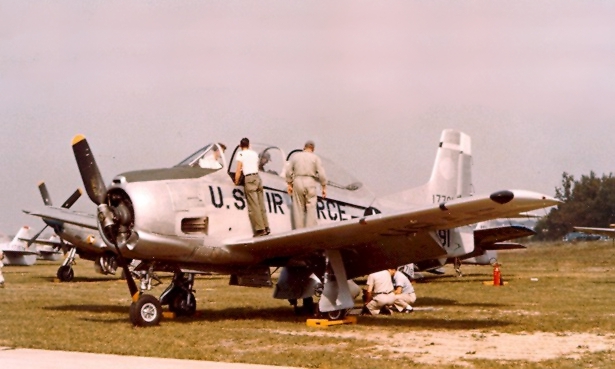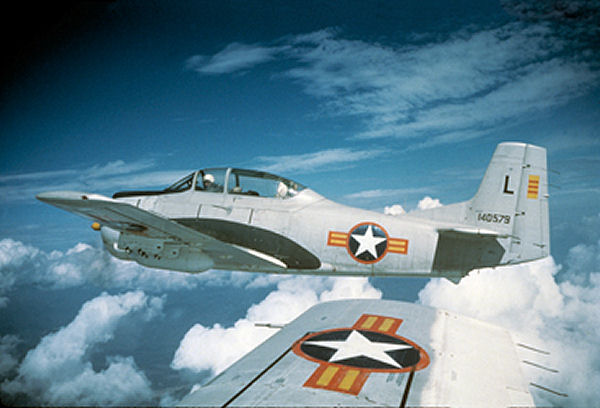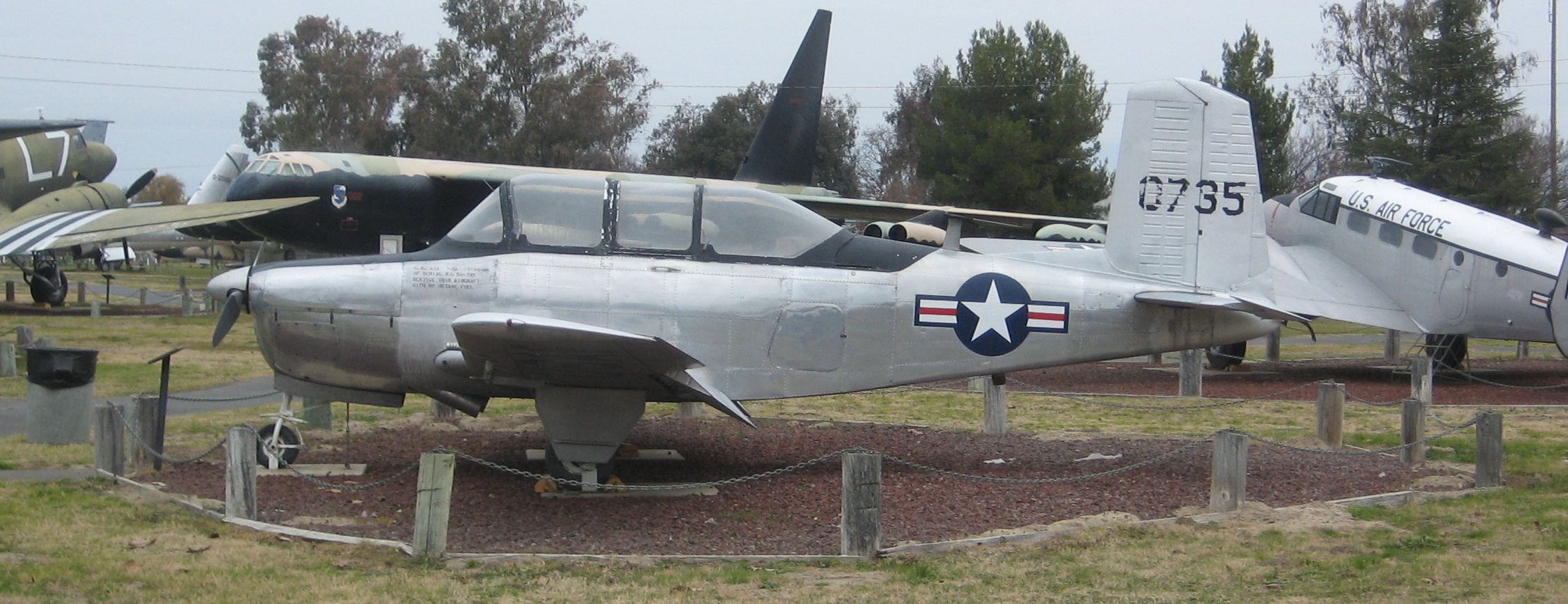|
VT-27
VT-27 is a primary training squadron of the United States Navy. One of just five Navy primary training squadrons, VT-27 is one of two located on the Texas Coastal Bend. History Trainin Squadron 27 was initially established on July 11, 1951 as Advanced Training Unit-B at Naval Air Station, Corpus Christi. The command moved to Naval Air Station, Kingsville in 1952 and again to Naval Air Station, New Iberia, Louisiana in 1960. It was there the squadron was redesignated VT-27 in July of that year and about that time that the Grumman S2F-1T Tracker was put into service as a multi-engine trainer. In September 1962 the 1962 United States Tri-Service aircraft designation system changed the Tracker's designation to TS-2A. In July 1964, the "Boomers" were returned to Naval Air Station, Corpus Christi where they continue to be an important part of the community. In 1973, the squadron began a transition to the role of a primary training squadron with the arrival on 1 August of the first ... [...More Info...] [...Related Items...] OR: [Wikipedia] [Google] [Baidu] |
Naval Air Station New Iberia
Naval Air Station New Iberia, located near New Iberia, Louisiana, was a short-lived training facility of the United States Navy which operated for a mere five years in the 1960s. The naval base at New Iberia was actually designated NAAS, indicating that it was a Naval Auxiliary Air Station. The U.S. Navy airfield identifier for New Iberia was KNIL. History The site of NAAS New Iberia had served as a civil airport between 1946 and 1954. In 1954 the Department of Defense selected the airport for development as a naval air station. Due to the runway length requirements of naval jet aircraft, 4,000 acres were purchased by the Federal Government and an 8,002-foot concrete runway, Runway 16/34, was constructed. Commissioned in 1960, Naval Auxiliary Air Station New Iberia was located near U.S. Highway 90 just outside New Iberia and covered an area of 4,347 acres of land and had an elevation of 24 feet. With the opening of NAAS New Iberia, its primary flying unit, Advanced Training Unit- ... [...More Info...] [...Related Items...] OR: [Wikipedia] [Google] [Baidu] |
Naval Air Station Corpus Christi
Naval Air Station Corpus Christi is a United States Navy naval air base located six miles (10 km) southeast of the central business district (CBD) of Corpus Christi, in Nueces County, Texas. History A naval air station for Corpus Christi had been proposed since the mid-1930s, and the city's congressman, Richard M. Kleberg, supported it. But it remained a low priority construction project for the U.S. Navy as late as January 9, 1940. (The Kleberg family and Roy Miller both supported Vice President John Nance Garner's quest for the 1940 presidential nomination.) Rep. Lyndon B. Johnson made himself a key Texas ally of President Franklin D. Roosevelt's bid for a third term, and the White House told the Navy Department to consult Johnson, and heed his advice, on Navy contracts in Texas. By February 1940, the project was on the Navy's preferred list. Brown & Root, a Houston firm, shared the construction contract with another New Deal supporter, Henry Kaiser; the preside ... [...More Info...] [...Related Items...] OR: [Wikipedia] [Google] [Baidu] |
List Of United States Navy Aircraft Squadrons
This is a list of active United States Navy aircraft squadrons. ''Deactivated'' or ''disestablished'' squadrons are listed in the List of inactive United States Navy aircraft squadrons. Navy aircraft squadrons are composed of several aircraft (from as few as about four to as many as about a dozen), the officers who fly them, the officers and sailors who maintain them and administrative support officers and sailors. Some of the units listed in this article are not technically "squadrons", but they all operate U.S. Navy aircraft in some capacity. Squadrons and their history are listed in the '' Dictionary of American Naval Aviation Squadrons'' (DANAS). Squadron organization Active duty squadrons are typically Time commanded by a commander. Second in command is the executive officer (XO), also a commander. The XO typically assumes command of the squadron after approximately 15 months. There are typically four functional departments – Operations, Maintenance, Safety/NATOPS, and A ... [...More Info...] [...Related Items...] OR: [Wikipedia] [Google] [Baidu] |
Grumman S-2 Tracker
The Grumman S-2 Tracker (S2F prior to 1962) was the first purpose-built, single airframe anti-submarine warfare (ASW) aircraft to enter service with the United States Navy. Designed and initially built by Grumman, the Tracker was of conventional design — propeller-driven with twin radial engines, a high wing that could be folded for storage on aircraft carriers, and tricycle undercarriage. The type was exported to a number of navies around the world. Introduced in 1952, the Tracker and its E-1 Tracer derivative saw service in the U.S. Navy until the mid-1970s, and its C-1 Trader derivative until the mid-1980s, with a few aircraft remaining in service with other air arms into the 21st century. Argentina and Brazil are the last countries to still use the Tracker. Design and development The Tracker was intended as a replacement for the Grumman AF Guardian, which was the first purpose-built aircraft system for ASW, using two airframes for two versions, one with the det ... [...More Info...] [...Related Items...] OR: [Wikipedia] [Google] [Baidu] |
T-28 Trojan
The North American Aviation T-28 Trojan is a radial-engine military trainer aircraft manufactured by North American Aviation and used by the United States Air Force and United States Navy beginning in the 1950s. Besides its use as a trainer, the T-28 was successfully employed as a counter-insurgency aircraft, primarily during the Vietnam War. It has continued in civilian use as an aerobatics and warbird performer. Design and development On September 24, 1949, the XT-28 (company designation NA-159) was flown for the first time, designed to replace the T-6 Texan. The T-28A arrived at the Air Proving Ground, Eglin Air Force Base, Florida, in mid-June 1950, for suitability tests as an advanced trainer by the 3200th Fighter Test Squadron, with consideration given to its transition, instrument, and gunnery capabilities. Found satisfactory, a contract was issued and between 1950 and 1957, a total of 1,948 were built. Following the T-28's withdrawal from U.S. military service, a nu ... [...More Info...] [...Related Items...] OR: [Wikipedia] [Google] [Baidu] |
North American T-28 Trojan
The North American Aviation T-28 Trojan is a radial-engine military trainer aircraft manufactured by North American Aviation and used by the United States Air Force and United States Navy beginning in the 1950s. Besides its use as a trainer, the T-28 was successfully employed as a counter-insurgency aircraft, primarily during the Vietnam War. It has continued in civilian use as an aerobatics and warbird performer. Design and development On September 24, 1949, the XT-28 (company designation NA-159) was flown for the first time, designed to replace the T-6 Texan. The T-28A arrived at the Air Proving Ground, Eglin Air Force Base, Florida, in mid-June 1950, for suitability tests as an advanced trainer by the 3200th Fighter Test Squadron, with consideration given to its transition, instrument, and gunnery capabilities. Found satisfactory, a contract was issued and between 1950 and 1957, a total of 1,948 were built. Following the T-28's withdrawal from U.S. military service, a numb ... [...More Info...] [...Related Items...] OR: [Wikipedia] [Google] [Baidu] |
United States Department Of The Navy Seal
United may refer to: Places * United, Pennsylvania, an unincorporated community * United, West Virginia, an unincorporated community Arts and entertainment Films * ''United'' (2003 film), a Norwegian film * ''United'' (2011 film), a BBC Two film Literature * ''United!'' (novel), a 1973 children's novel by Michael Hardcastle Music * United (band), Japanese thrash metal band formed in 1981 Albums * ''United'' (Commodores album), 1986 * ''United'' (Dream Evil album), 2006 * ''United'' (Marvin Gaye and Tammi Terrell album), 1967 * ''United'' (Marian Gold album), 1996 * ''United'' (Phoenix album), 2000 * ''United'' (Woody Shaw album), 1981 Songs * "United" (Judas Priest song), 1980 * "United" (Prince Ital Joe and Marky Mark song), 1994 * "United" (Robbie Williams song), 2000 * "United", a song by Danish duo Nik & Jay featuring Lisa Rowe Television * ''United'' (TV series), a 1990 BBC Two documentary series * ''United!'', a soap opera that aired on BBC One from 1965 ... [...More Info...] [...Related Items...] OR: [Wikipedia] [Google] [Baidu] |
History Of The United States Navy
The history of the United States Navy divides into two major periods: the "Old Navy", a small but respected force of sailing ships that was notable for innovation in the use of ironclads during the American Civil War, and the "New Navy" the result of a modernization effort that began in the 1880s and made it the largest in the world by 1943. The United States Navy claims October 13, 1775 as the date of its official establishment, when the Second Continental Congress passed a resolution creating the Continental Navy. With the end of the American Revolutionary War, the Continental Navy was disbanded. Under the Presidency of John Adams, merchant shipping came under threat while in the Mediterranean by Barbary pirates from four North African States. This led to the Naval Act of 1794, which created a permanent standing U.S. Navy. The original six frigates were authorized as part of the Act. Over the next 20 years, the Navy fought the French Republic Navy in the Quasi-War (1 ... [...More Info...] [...Related Items...] OR: [Wikipedia] [Google] [Baidu] |
Training Air Wing Four
Training is teaching, or developing in oneself or others, any skills and knowledge or fitness that relate to specific useful competencies. Training has specific goals of improving one's capability, capacity, productivity and performance. It forms the core of apprenticeships and provides the backbone of content at institutes of technology (also known as technical colleges or polytechnics). In addition to the basic training required for a trade, occupation or profession, training may continue beyond initial competence to maintain, upgrade and update skills throughout working life. People within some professions and occupations may refer to this sort of training as professional development. Training also refers to the development of physical fitness related to a specific competence, such as sport, martial arts, military applications and some other occupations. Types Physical training Physical training concentrates on mechanistic goals: training programs in this area de ... [...More Info...] [...Related Items...] OR: [Wikipedia] [Google] [Baidu] |
Naval Air Station Kingsville
Naval Air Station Kingsville or NAS Kingsville (NASK) is a United States Navy Naval Air Station located approximately 3 miles east of Kingsville, Texas in Kleberg County. NAS Kingsville is under the jurisdiction of Navy Region Southeast and is the headquarters of Training Air Wing Two. The station also operates a nearby satellite airfield, NALF Orange Grove. Founded in 1942 as Naval Auxiliary Air Station (NAAS) Kingsville, it served nearby Naval Air Station Corpus Christi as an auxiliary field, aiding in training many of the U.S Navy's pilots for World War II. In 1968, the airfield was redesignated as Naval Air Station Kingsville, and has hosted flight training operations throughout its existence. Additionally, NAS Kingsville organizes and hosts the annual Wings Over South Texas Air Show. Current operations Naval Air Station Kingsville is one of the U.S. Navy’s premier locations for jet aviation training. The naval air station’s primary mission is to train Student Na ... [...More Info...] [...Related Items...] OR: [Wikipedia] [Google] [Baidu] |
T-34 Mentor
The Beechcraft T-34 Mentor is an American propeller-driven, single-engined, military trainer aircraft derived from the Beechcraft Model 35 Bonanza. The earlier versions of the T-34, dating from around the late 1940s to the 1950s, were piston-engined. These were eventually succeeded by the upgraded T-34C Turbo-Mentor, powered by a turboprop engine. The T-34 remains in service more than seven decades after it was first designed. Design and development The T-34 was the brainchild of Walter Beech, who developed it as the Beechcraft Model 45 private venture at a time when there was no defense budget for a new trainer model. Beech hoped to sell it as an economical alternative to the North American T-6/SNJ Texan, then in use by all services of the U.S. military. Three initial design concepts were developed for the Model 45, including one with the Bonanza's signature V-tail, but the final design that emerged in 1948 incorporated conventional tail control surfaces for the benef ... [...More Info...] [...Related Items...] OR: [Wikipedia] [Google] [Baidu] |
Beechcraft T-34 Mentor
The Beechcraft T-34 Mentor is an American propeller-driven, single-engined, military trainer aircraft derived from the Beechcraft Model 35 Bonanza. The earlier versions of the T-34, dating from around the late 1940s to the 1950s, were piston-engined. These were eventually succeeded by the upgraded T-34C Turbo-Mentor, powered by a turboprop engine. The T-34 remains in service more than seven decades after it was first designed. Design and development The T-34 was the brainchild of Walter Beech, who developed it as the Beechcraft Model 45 private venture at a time when there was no defense budget for a new trainer model. Beech hoped to sell it as an economical alternative to the North American T-6/SNJ Texan, then in use by all services of the U.S. military. Three initial design concepts were developed for the Model 45, including one with the Bonanza's signature V-tail, but the final design that emerged in 1948 incorporated conventional tail control surfaces for the benef ... [...More Info...] [...Related Items...] OR: [Wikipedia] [Google] [Baidu] |








